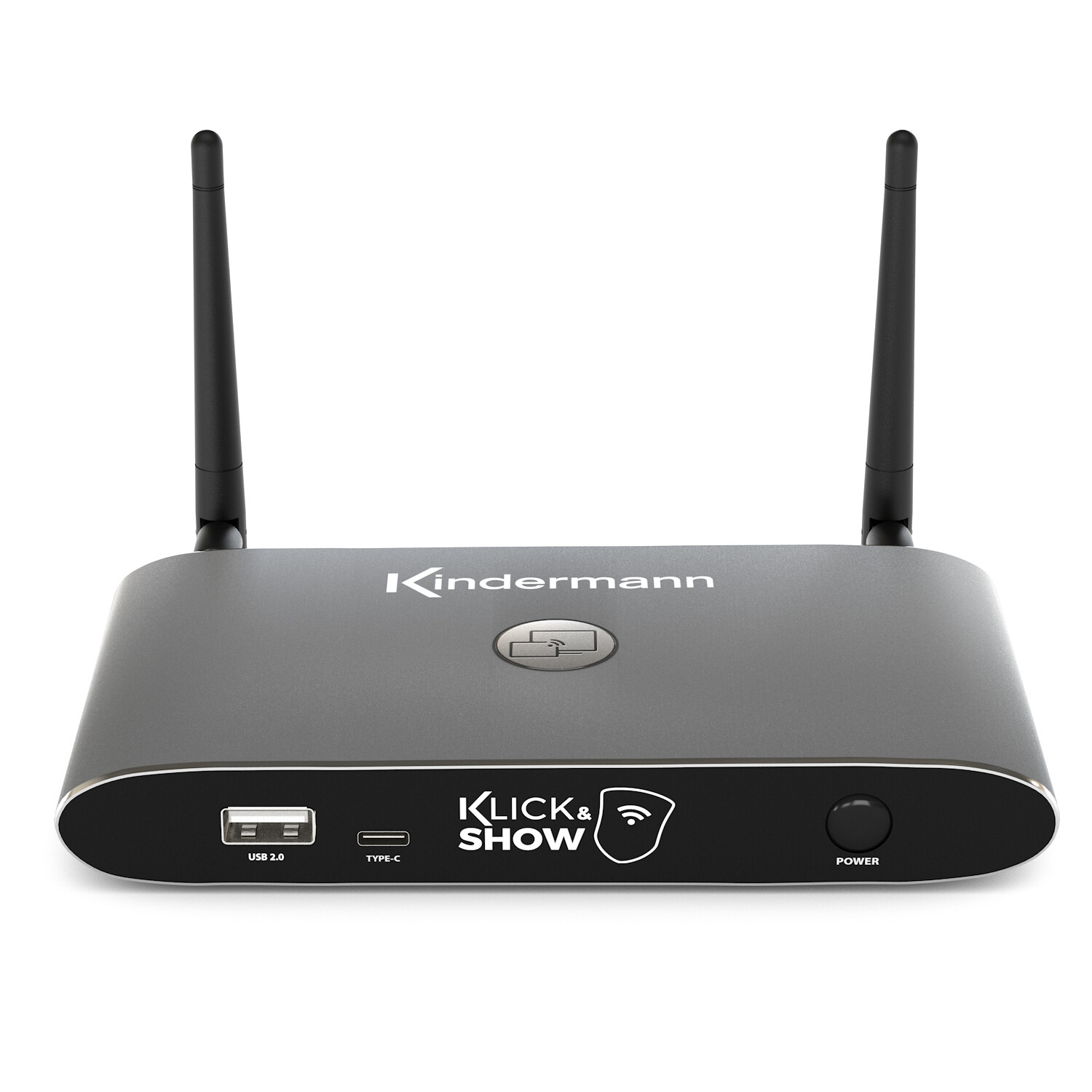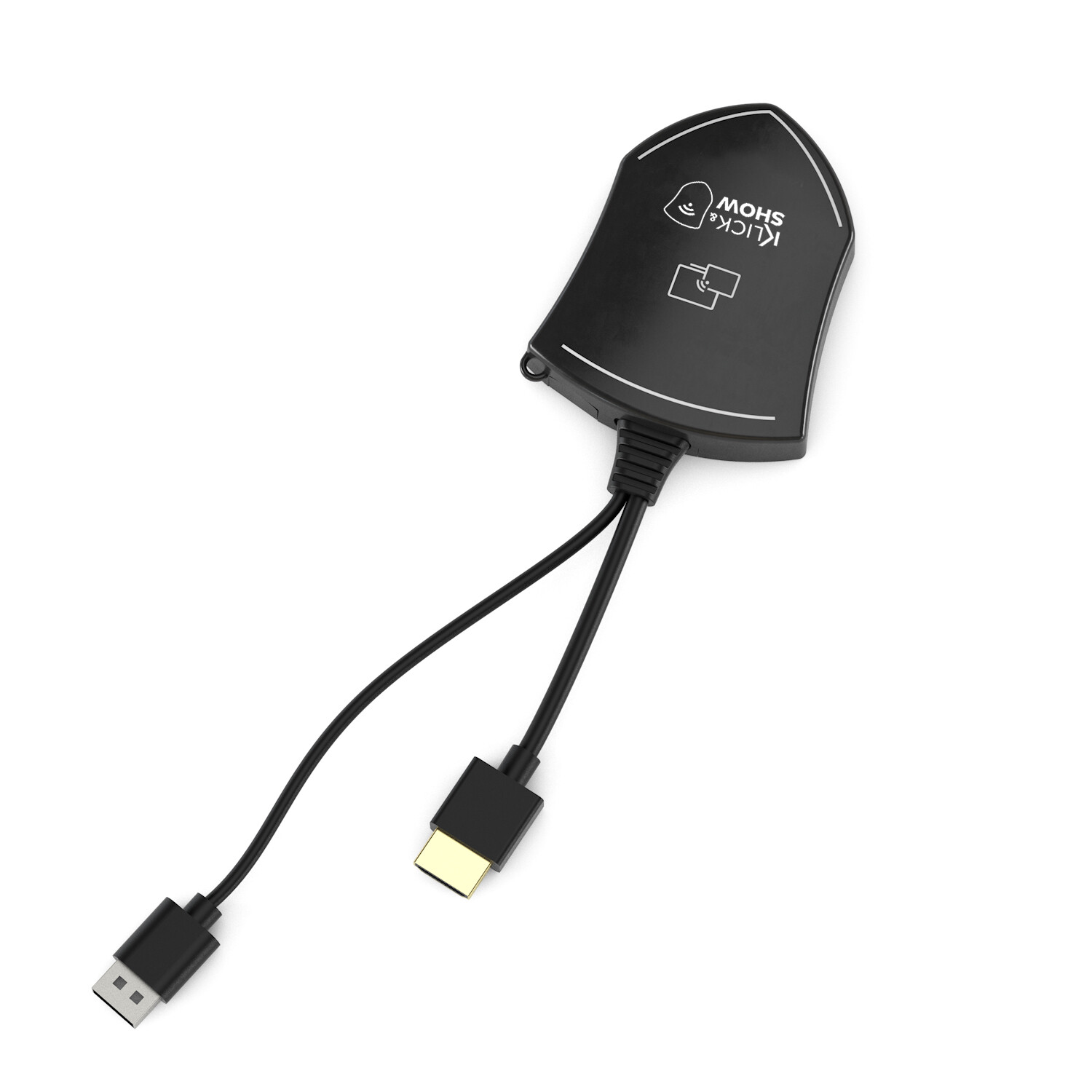







£546.92*


Frequently purchased together
Product information
KLICK & SHOW K-40 Base Unit is a universal wireless presentation system that fits perfectly in meeting rooms, huddle spaces and classrooms and training rooms and supports BYOD (bring your own device). With KLICK & SHOW, users can easily share audio-visual content from their laptops or mobile devices - no cables, no hassle and no time wasted.
Laptop users simply launch the Klick & Show Universal PC client software (available for download at www.KlickandShow.com or via the base unit) to mirror live content to the main screen.
Content from mobile phones and tablets can be shared just as easily via Airplay, Miracast, Chromecast or using the free Android app.
Tailor your K-40 base unit to your needs by adding any combination of the three optional KLICK & SHOW WIFI TOUCH transmitters to include laptop users in your KLICK & SHOW meeting with a "plug & play"-like user experience: Simply connect the transmitter to your device and touch the transmitter's sensor button to share your live content.
The optional USB-A TOUCH transmitters are designed to work in combination with the Universal PC Client for Windows and macOS, while the optional HDMI or USB-C TOUCH transmitters enable presentations entirely without a PC client.
Just present the way you want: with or without a WIFI transmitter - with or without a PC client - all mixed in the same meeting!
- Universal, cross-platform BYOD solution for wireless presentations
- Easily present live audiovisual content from laptops and mobile devices
- Designed for diverse, professional use cases in corporate and educational environments
- Present with or without a WIFI transmitter, with or without a PC client - all mixed in the same meeting
- 3 KLICK & SHOW TOUCH transmitter types to choose from: HDMI, USB-C and USB-A
- Add more optional transmitters to include more participants in the meeting and increase device compatibility
- Intuitive to use and secure
Universal, cross-platform solution:
From Windows, macOS and Linux to iOS or Android - simply present the way you want!
KLICK & SHOW is designed to be a highly device-compatible, platform-independent presentation system for commercial use, supporting all major operating systems, including native support for Apple Airplay, Miracast and Chromecast.
3 elegant WIFI transmitters to choose from:
The 3 different types of KLICK & SHOW TOUCH transmitters make your meeting a true plug & play experience. All of them have the unique integrated sensor button to activate the live transmission of their content. Status feedback is provided to the user via the two-colour LED indicator and the transmitter's exclusive vibration function for subtle haptic feedback. Simply add more transmitters of any type to your existing kit to bring more people into the meeting and ensure maximum compatibility with all staff and guest laptops.
Plug & Play:
KLICK & SHOW HDMI and USB-C transmitters are true plug & play devices. It's as easy as plugging in an external PC monitor: simply connect the transmitter to your computer's video port and touch the transmitter's sensor button to wirelessly stream your laptop's content to the main screen. KLICK & SHOW USB-A transmitters work in conjunction with a free PC client available for Windows or macOS, with no installation or admin rights required. The combination of USB-A transmitter and PC client is ideal for enabling older laptops with bulky VGA, DVI, standard DisplayPort or mini DisplayPort video connections to participate wirelessly in meetings. In addition, the PC client can also be used for software-only access to the meeting.
Low latency wireless transmission:
Despite the wireless signal transmission, your screen is mirrored in brilliant Full HD resolution with virtually no visible latency, which is an outstanding feature of KLICK & SHOW.
High-resolution 4K split-screen output:
With KLICK & SHOW, you can view and compare content from up to 4 different devices simultaneously, for more productive meetings. The combined live split-screen output is in high 4K resolution for optimal readability of even detailed content.
Interactive touch-back feature:
The touch-back feature of KLICK & SHOW allows you to control your laptop from the back of any compatible large format interactive display or interactive whiteboard used as the main display device in the room, for more interactive meetings. KLICK & SHOW's touch-back feature even works in 4-user split-screen mode to control up to 4 laptops simultaneously, with minimal latency for an intuitive workflow.
Whiteboarding & Annotation:
KLICK & SHOW is fully equipped with essential tools for more productive meetings. Combined with a large-format interactive screen as the main display, you can capture impromptu brainstorming sessions on a blank canvas in whiteboarding mode - or switch to annotation mode to highlight or annotate relevant topics on the main screen. You can then capture screenshots and share them with all participants.
Extended Desktop:
Professional users will be thrilled with the ability to mirror either the primary or secondary laptop desktop. The Enhanced Desktop option allows for perfect PowerPoint presentations with preview function.
Include 30 participants in the meeting:
Up to 30 devices can be connected simultaneously to a KLICK & SHOW base, either via one of three types of WIFI transmitters, the available software PC client, the native Airplay, Miracast or Chromecast protocol, or the free Android app. Use the KLICK & SHOW moderator feature to manage potential presenters via thumbnails.
Security is important:
IT security is important in commercial settings. KLICK & SHOW offers a high level of data security through secure WIFI transmission based on AES WPA2 PSK authentication. As a further protective measure, the captured laptop data stream is additionally encrypted with a second level of up to 256/1024 bits before the actual data is transmitted wirelessly.
Integration into corporate networks and management:
KLICK & SHOW's integrated configurable WIFI hotspot and web server enable quick and easy plug & play setup in typical environments, without the need for integration into the corporate network. KLICK & SHOW comes pre-configured and ready to use. However, the system can also be configured as part of a corporate network, e.g. in large-scale deployments, even with separate routing for staff and guests, or to provide Internet access and central remote administration.
Technical data
| Name | Kindermann Klick & Show K-40 Base Unit |
|---|---|
| Article number | 1000018898 |
| GTIN/EAN | 4021565072772 |
| Manufacturer SKU | 7488000315 |
| Model name | Klick & Show K-40 |
| Brand | Kindermann |
| Product Type | Wireless Presentation |
| Product Series | Kindermann Klick & Show Series |
| Inputs | 1x RS232 , 1x USB-C , 2x Ethernet , 2x USB-A |
| Outputs | 1x HDMI |
| Product width | 20 cm |
| Product height | 6.5 cm |
| Product depth | 25.5 cm |
| Weight | 1 kg |
| Condition | New |
| Warranty type | Bringin service Service and support information |
Product safety
| Person responsible for the EU |
|---|
| Kindermann GmbH |
| Mainparkring 3 |
| 97246 Eibelstadt |
| Germany |
| info@kindermann.de |




